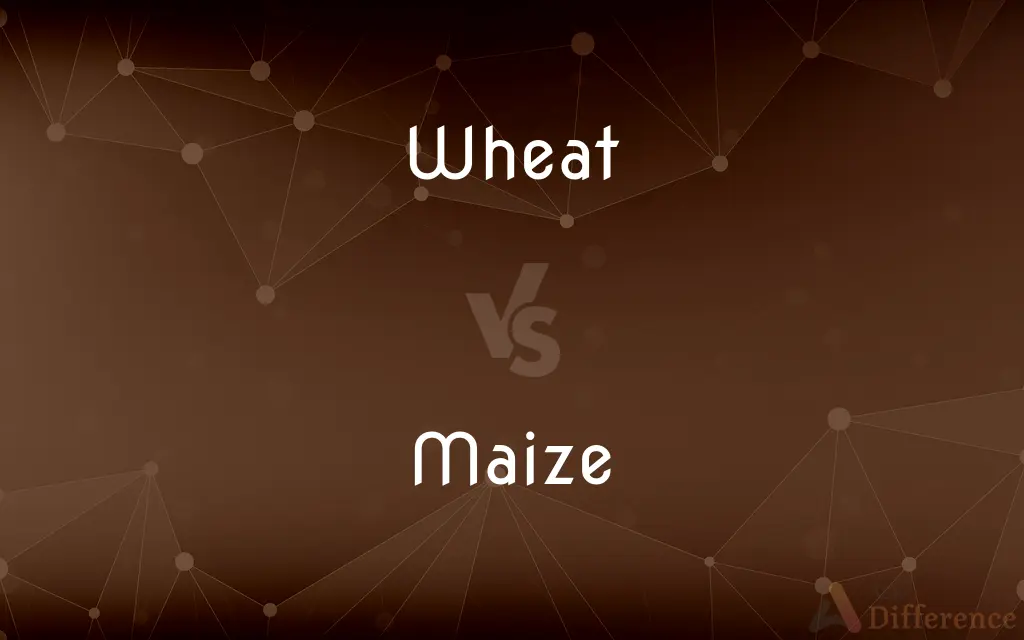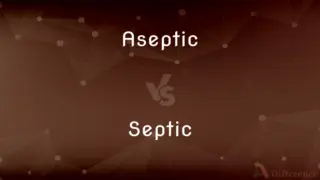Wheat vs. Maize — What's the Difference?
Edited by Tayyaba Rehman — By Fiza Rafique — Updated on November 3, 2023
Wheat is a cereal grain used for flour and bread, while maize, also known as corn, is a staple crop used for food and feed.

Difference Between Wheat and Maize
Table of Contents
ADVERTISEMENT
Key Differences
Wheat is a grass widely cultivated for its seed, a cereal grain which is a worldwide staple food. Maize, commonly known as corn in North America, is a large grain plant domesticated by indigenous peoples in southern Mexico. While wheat is primarily used for baking bread due to its high gluten content, maize is used in a variety of culinary practices, including making cornmeal and as a staple in many regions.
The gluten found in wheat is essential for giving bread its elastic texture, allowing it to rise during baking. Maize, on the other hand, lacks sufficient gluten, which is why bread made solely from cornmeal has a different texture and does not rise in the same way. Wheat is also processed into semolina, used in pasta, while maize is often processed into grits or used to produce corn syrup and oil.
Historically, wheat has been a staple in the Middle Eastern and European diets, while maize has been more significant in the Americas. The cultivation of wheat is suited to temperate climates, whereas maize can thrive in warmer environments. Wheat fields are typically found in regions like North America, Europe, and Asia, while maize is widely grown in the Americas, Africa, and parts of Asia.
Nutritionally, wheat and maize differ as well. Wheat typically contains more protein and fiber than maize but also contains gluten, which can be problematic for those with celiac disease or gluten sensitivity. Maize is often praised for its high vitamin content and is a vital source of carbohydrates, dietary fibers, and essential fats.
Comparison Chart
Primary Use
Flour for bread, pasta, and cereal
Cornmeal, grits, sweeteners
ADVERTISEMENT
Gluten Content
High gluten content for elasticity
Gluten-free
Growing Climate
Temperate regions
Warmer regions
Historical Significance
Staple in Middle East and Europe
Staple in the Americas
Nutritional Content
Higher in protein and fiber
High in vitamins, lower in gluten
Compare with Definitions
Wheat
The grain of the wheat plant, ground to make flour.
Wheat is often milled into flour for bread making.
Maize
A cereal grain known as corn.
Fields of maize stood tall in the rural landscape.
Wheat
A member of the grass family used in culinary dishes.
I mixed wheat into the soup to add texture.
Maize
The kernels or seeds of the corn plant.
She boiled the maize to make a side dish for dinner.
Wheat
A staple food used in many forms.
Her diet included whole wheat because of its health benefits.
Maize
A source of food for humans and livestock.
Livestock feed often includes maize because of its nutritional value.
Wheat
Wheaten, of a light brown colour, like that of wheat.
Maize
A staple crop in many indigenous American cultures.
Maize has been cultivated by Native Americans for thousands of years.
Wheat
A cereal plant cultivated for its grain.
The farmers harvested the wheat in late summer.
Maize
Maize ( MAYZ; Zea mays subsp. mays, from Spanish: maíz after Taino: mahiz), also known as corn (North American and Australian English), is a cereal grain first domesticated by indigenous peoples in southern Mexico about 10,000 years ago.
Wheat
A symbol of agricultural fertility.
Wheat sheaves decorated the barn for the harvest festival.
Maize
A Central American cereal plant that yields large grains (corn or sweetcorn) set in rows on a cob. The many varieties include some used for stockfeed and corn oil.
Wheat
Wheat is a grass widely cultivated for its seed, a cereal grain which is a worldwide staple food. The many species of wheat together make up the genus Triticum; the most widely grown is common wheat (T. aestivum).
Maize
See corn1.
Wheat
A cereal which is the most important kind grown in temperate countries, the grain of which is ground to make flour for bread, pasta, pastry, etc.
Maize
A light yellow to moderate orange yellow.
Wheat
Any of various annual cereal grasses of the genus Triticum of the Mediterranean region and southwest Asia, especially T. aestivum, widely cultivated in temperate regions in many varieties for its commercially important edible grain.
Maize
Corn; a type of grain of the species Zea mays.
Wheat
The grain of any of these grasses, ground to produce flour used in breads, pasta, and other foods.
Maize
A large species of American grass of the genus Zea (Zea Mays), widely cultivated as a forage and food plant; Indian corn, commonly called corn. Also, its seed, growing on cobs, and used as food for men and animals.
Wheat
(countable) Any of several cereal grains, of the genus Triticum, that yields flour as used in bakery.
Maize
Tall annual cereal grass bearing kernels on large ears: widely cultivated in America in many varieties; the principal cereal in Mexico and Central and South America since pre-Columbian times
Wheat
(uncountable) A light brown colour, like that of wheat.
Maize
A strong yellow color
Wheat
A cereal grass (Triticum vulgare) and its grain, which furnishes a white flour for bread, and, next to rice, is the grain most largely used by the human race.
Maize
A plant that can be processed into various products.
Maize is a versatile crop, often used to make corn syrup.
Wheat
Annual or biennial grass having erect flower spikes and light brown grains
Wheat
Grains of common wheat; sometimes cooked whole or cracked as cereal; usually ground into flour
Common Curiosities
What part of the wheat plant is edible?
The grain or seed of the wheat plant is edible.
Is maize the same as corn?
Yes, maize is another name for corn, primarily used outside North America.
Can wheat be eaten by people with gluten intolerance?
No, people with gluten intolerance should avoid wheat due to its gluten content.
What are the byproducts of maize?
Maize byproducts include corn oil, cornstarch, and corn syrup.
Is wheat grown year-round?
Wheat is typically grown seasonally, depending on the climate.
How many types of maize are there?
There are several types of maize, including sweet corn, field corn, and popcorn.
Which has more fiber, wheat or maize?
Whole wheat generally has more fiber than maize.
What is the main difference between wheat flour and maize flour?
Wheat flour contains gluten, which makes it suitable for bread, while maize flour does not.
Are wheat and maize used in animal feed?
Yes, both are used in animal feed but in different forms.
Can maize be used to make bread?
Yes, but it is often combined with wheat flour to provide the necessary gluten.
What climate does maize prefer?
Maize prefers a warm climate with good soil moisture.
Are wheat and maize genetically modified?
Certain varieties of both crops have genetically modified versions to improve yield and pest resistance.
Is whole wheat the same as refined wheat?
No, whole wheat contains the entire grain, while refined wheat has the bran and germ removed.
Is maize a common allergen?
Maize is not a common allergen, unlike wheat.
Does wheat or maize have a higher yield per acre?
This depends on the region and farming practices, but wheat often has a higher yield in temperate climates.
Share Your Discovery

Previous Comparison
Preliminary vs. Draft
Next Comparison
Aseptic vs. SepticAuthor Spotlight
Written by
Fiza RafiqueFiza Rafique is a skilled content writer at AskDifference.com, where she meticulously refines and enhances written pieces. Drawing from her vast editorial expertise, Fiza ensures clarity, accuracy, and precision in every article. Passionate about language, she continually seeks to elevate the quality of content for readers worldwide.
Edited by
Tayyaba RehmanTayyaba Rehman is a distinguished writer, currently serving as a primary contributor to askdifference.com. As a researcher in semantics and etymology, Tayyaba's passion for the complexity of languages and their distinctions has found a perfect home on the platform. Tayyaba delves into the intricacies of language, distinguishing between commonly confused words and phrases, thereby providing clarity for readers worldwide.
















































